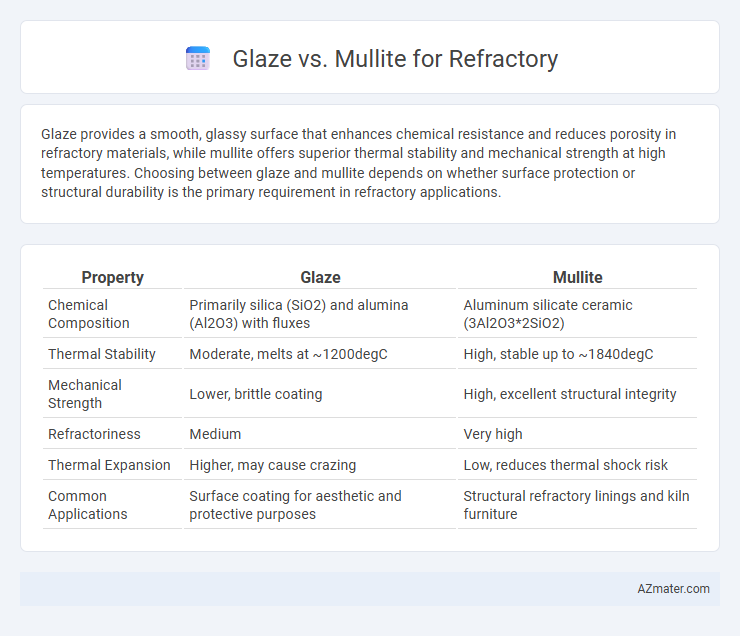Glaze provides a smooth, glassy surface that enhances chemical resistance and reduces porosity in refractory materials, while mullite offers superior thermal stability and mechanical strength at high temperatures. Choosing between glaze and mullite depends on whether surface protection or structural durability is the primary requirement in refractory applications.
Table of Comparison
| Property | Glaze | Mullite |
|---|---|---|
| Chemical Composition | Primarily silica (SiO2) and alumina (Al2O3) with fluxes | Aluminum silicate ceramic (3Al2O3*2SiO2) |
| Thermal Stability | Moderate, melts at ~1200degC | High, stable up to ~1840degC |
| Mechanical Strength | Lower, brittle coating | High, excellent structural integrity |
| Refractoriness | Medium | Very high |
| Thermal Expansion | Higher, may cause crazing | Low, reduces thermal shock risk |
| Common Applications | Surface coating for aesthetic and protective purposes | Structural refractory linings and kiln furniture |
Introduction to Glaze and Mullite in Refractory Applications
Glaze and mullite serve distinct roles in refractory applications, where glaze acts as a protective coating that enhances surface durability and resistance to corrosion and chemical attack. Mullite, a silicate mineral composed mainly of aluminum oxide and silica, provides exceptional thermal stability and mechanical strength, making it ideal for high-temperature environments. Both materials contribute to the longevity and efficiency of refractory linings, with glaze offering surface protection and mullite ensuring structural integrity.
Chemical Composition: Glaze vs Mullite
Glaze primarily consists of silica (SiO2), fluxes such as potassium oxide (K2O) and sodium oxide (Na2O), along with alumina (Al2O3) in varying amounts, forming a glassy, non-crystalline coating that enhances surface smoothness and chemical resistance. Mullite, on the other hand, has a specific chemical composition dominated by 3Al2O3*2SiO2, characterized by high alumina content that provides exceptional thermal stability and mechanical strength in refractory applications. The distinct chemical compositions of glaze and mullite directly influence their thermal behavior, corrosion resistance, and suitability in high-temperature environments.
Thermal Stability: Performance Under High Temperatures
Glaze and mullite differ significantly in thermal stability when used in refractory applications, with mullite exhibiting superior performance at high temperatures up to 1750degC due to its excellent thermal shock resistance and low thermal expansion. Glaze coatings, while effective at providing a smooth surface and some protective qualities, tend to degrade or crack under extreme heat, limiting their longevity and structural integrity in refractory environments. Mullite's crystalline structure ensures consistent thermal stability and mechanical strength, making it ideal for high-temperature industrial processes such as kiln linings and furnace components.
Mechanical Strength and Durability Comparison
Mullite exhibits superior mechanical strength and durability compared to glaze in refractory applications due to its high melting point of approximately 1840degC and excellent thermal stability, which enhance resistance to thermal shock and mechanical stress. Glaze, while providing a smooth, protective coating, tends to be more brittle and less resistant to mechanical wear and cracking under high-temperature conditions. Therefore, mullite-based refractories offer enhanced longevity and structural integrity in demanding environments such as furnaces and kilns.
Resistance to Chemical Attack: Glaze vs Mullite
Glaze exhibits limited resistance to chemical attack compared to mullite, which offers superior durability in aggressive environments such as acidic or alkaline conditions. Mullite's crystalline structure provides enhanced stability and reduced solubility, making it ideal for refractory applications exposed to strong chemicals. This intrinsic chemical resilience of mullite ensures longer service life and reduced maintenance costs in industrial furnaces and kilns.
Application Methods and Processing Techniques
Glaze and mullite differ significantly in refractory application methods; glaze is typically applied as a liquid coating via spraying or dipping before firing, forming a smooth, glassy surface that enhances chemical resistance and reduces porosity. Mullite, synthesized through high-temperature firing of kaolin or alumina-silica mixtures, is integrated into refractory bricks or castables, providing superior thermal stability and mechanical strength. Processing techniques for mullite involve controlled sintering and crystallization, whereas glaze requires precise temperature control during firing to ensure proper vitrification and adherence.
Cost and Availability of Glaze and Mullite
Glaze materials tend to be more cost-effective and widely available compared to mullite, which is often more expensive due to its complex production process and higher purity requirements. Mullite's limited availability stems from its specialized manufacturing and natural scarcity, making it less accessible for large-scale refractory applications. The balance of cost and availability positions glaze as the preferred choice for budget-sensitive projects, while mullite is favored when superior thermal stability justifies the higher investment.
Longevity and Maintenance in Refractory Systems
Mullite exhibits superior longevity in refractory systems due to its high thermal stability and resistance to chemical corrosion, making it ideal for environments with prolonged exposure to extreme heat. Glaze surfaces, while providing a smooth, protective coating, tend to degrade faster under thermal cycling and mechanical stress, requiring more frequent maintenance to prevent spalling and cracking. Choosing mullite over glaze minimizes maintenance downtime and extends the operational lifespan of refractory linings in high-temperature industrial applications.
Industrial Use Cases: When to Choose Glaze or Mullite
Glaze coatings provide excellent surface smoothness and chemical resistance, making them ideal for applications in glass manufacturing and ceramic ware where aesthetic and cleanliness are critical. Mullite, known for its superior thermal shock resistance and mechanical strength, is preferred in high-temperature environments like kiln furniture, furnace linings, and petrochemical reactors. Industrial use cases demanding durability under rapid temperature changes favor mullite, while processes requiring low porosity and easy cleaning utilize glaze for optimal performance.
Conclusion: Selecting the Optimal Refractory Material
Selecting the optimal refractory material requires evaluating thermal stability, mechanical strength, and chemical resistance. Mullite offers superior high-temperature performance and resistance to thermal shock, making it ideal for extreme industrial applications. Glaze, while providing enhanced surface protection and corrosion resistance, may lack the structural durability needed for prolonged exposure to harsh conditions.

Infographic: Glaze vs Mullite for Refractory
 azmater.com
azmater.com